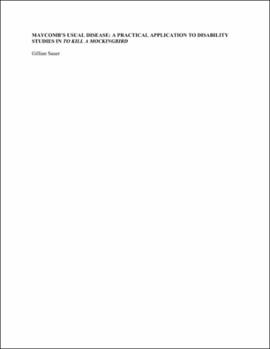| dc.contributor.author | Sauer, Gillian | |
| dc.date.accessioned | 2021-05-12T18:15:35Z | |
| dc.date.available | 2021-05-12T18:15:35Z | |
| dc.date.issued | 2021 | |
| dc.identifier.uri | https://hdl.handle.net/11244/329539 | |
| dc.description.abstract | This paper aims to connect literary studies and disability studies through the acknowledgement of disability in Harper Lee’s To Kill a Mockingbird. By analyzing Boo Radley as a character with autism, we can begin to discuss disability in high school classrooms. By using a novel typically found on high school reading lists in the United States, curriculum can be implemented to discuss disability as a facet of diversity. This analysis will focus on Boo Radley’s characterization, as well as the prevalence of disability in the fictional Maycomb. Putting a disability perspective on the novel will help to approach the idea of adding conversations of diversity to children’s literature. | en_US |
| dc.description.abstract | University Libraries Undergraduate Research Award | en_US |
| dc.language | en_US | en_US |
| dc.subject | Boo Radley | en_US |
| dc.subject | disability studies | en_US |
| dc.subject | diversity in children's literature | en_US |
| dc.subject | autism | en_US |
| dc.subject | neurodiversity | en_US |
| dc.subject | University Libraries Undergraduate Research Award | |
| dc.title | Maycomb's usual disease: A practical application to disability studies in "To Kill A Mockingbird" | en_US |
| dc.description.peerreview | No | en_US |
| dc.description.undergraduate | undergraduate | en_US |

